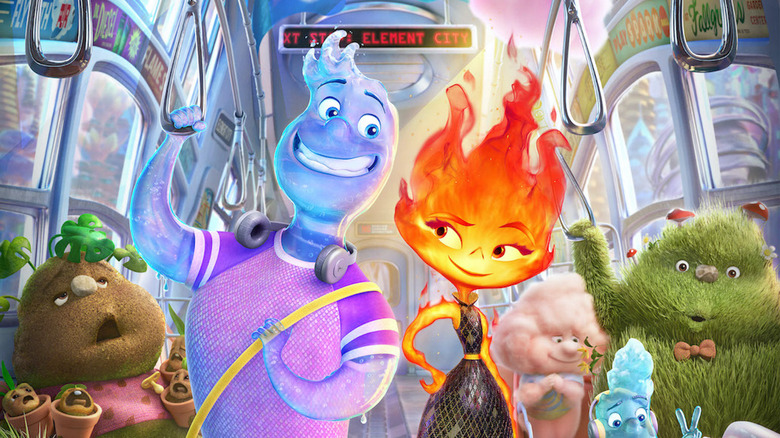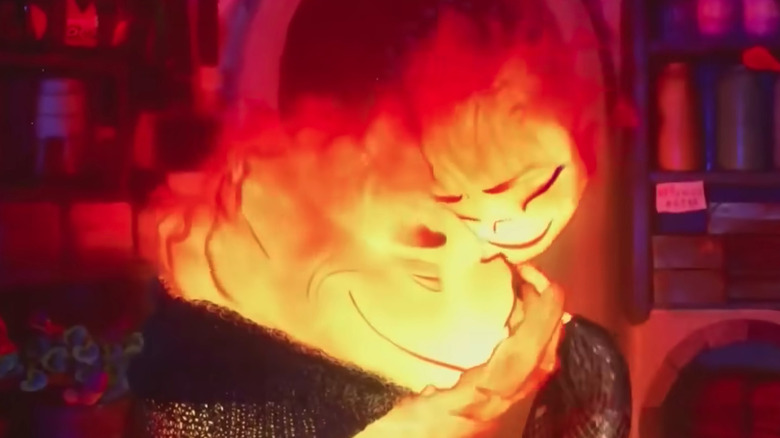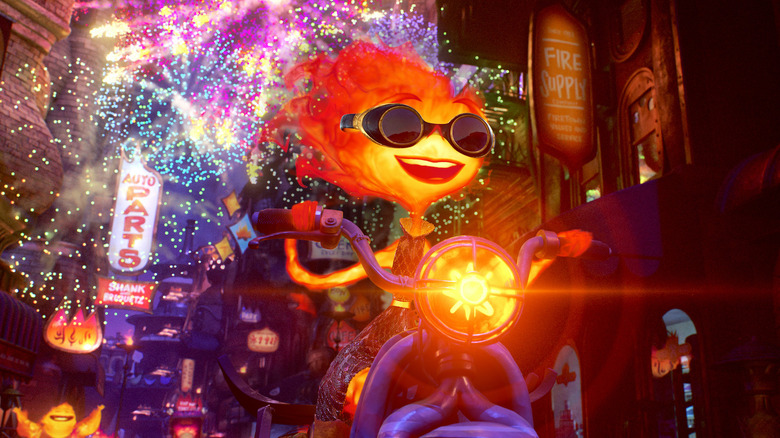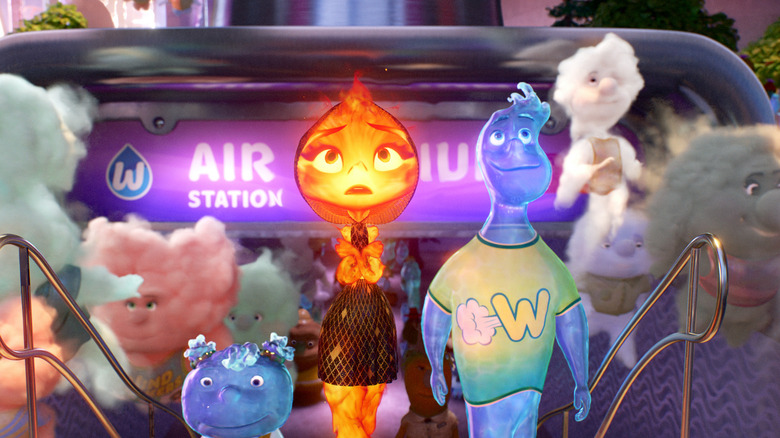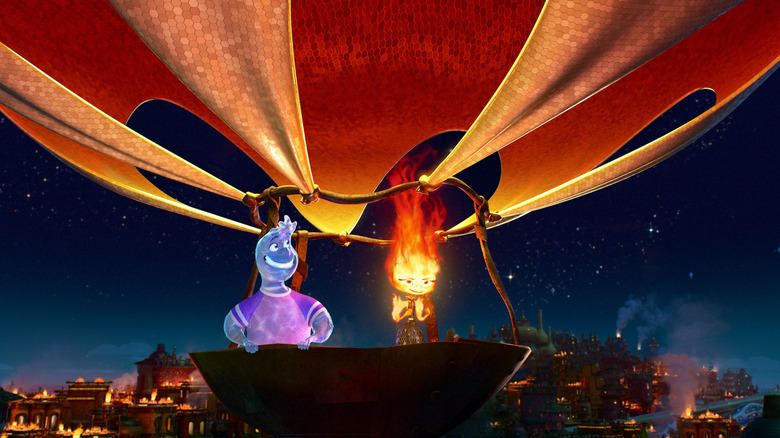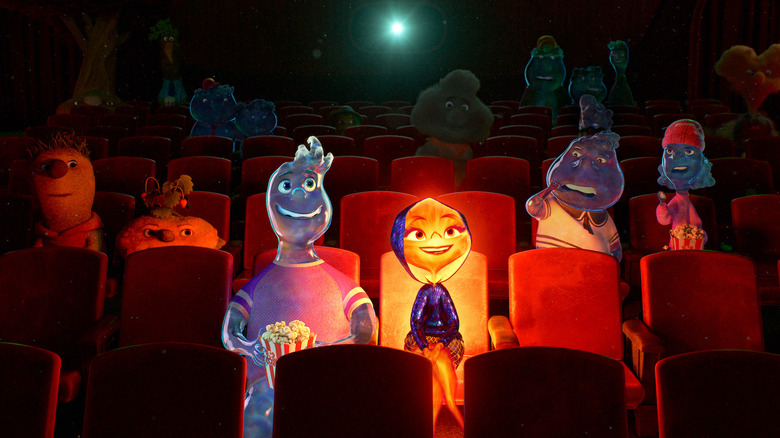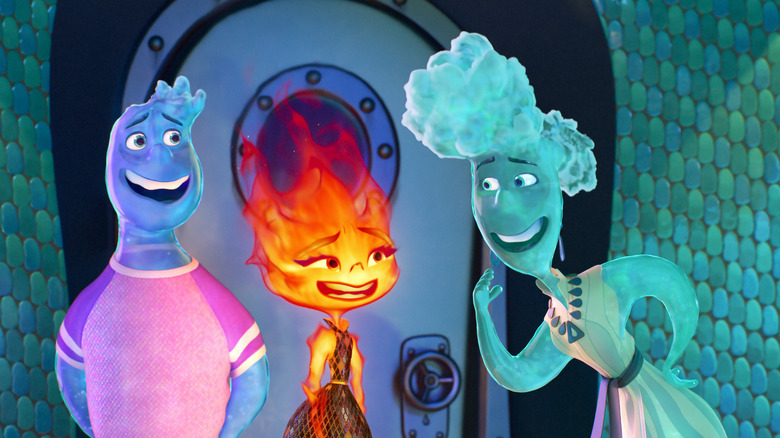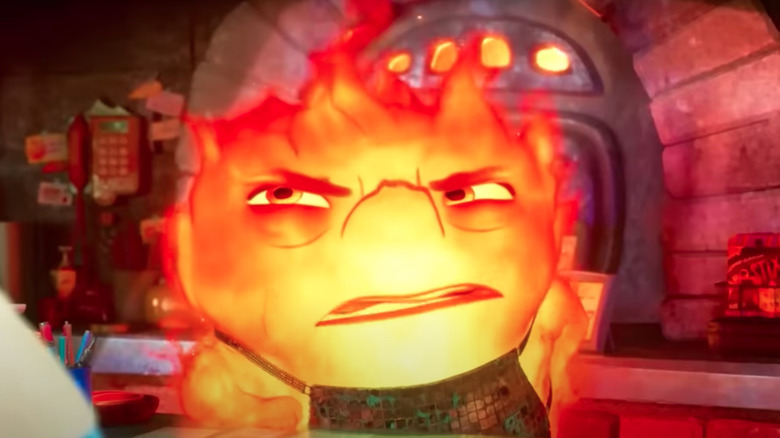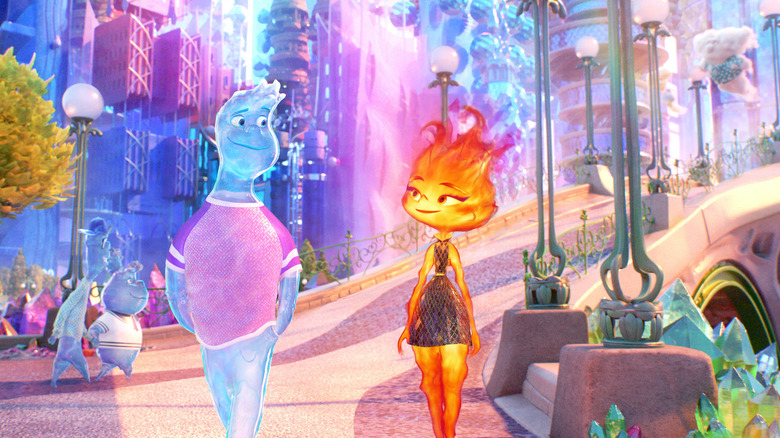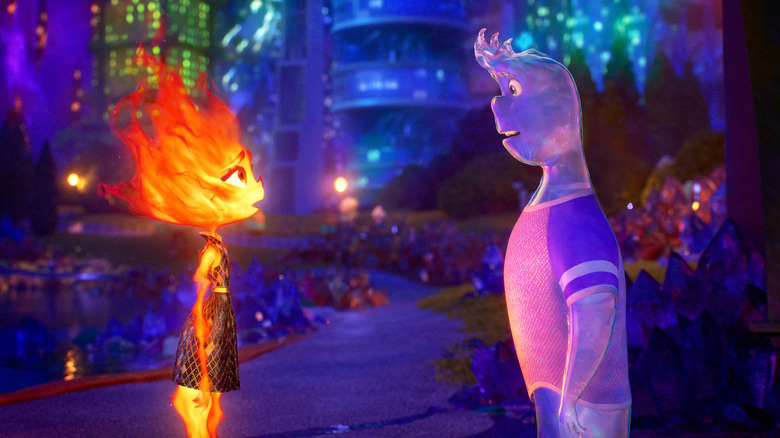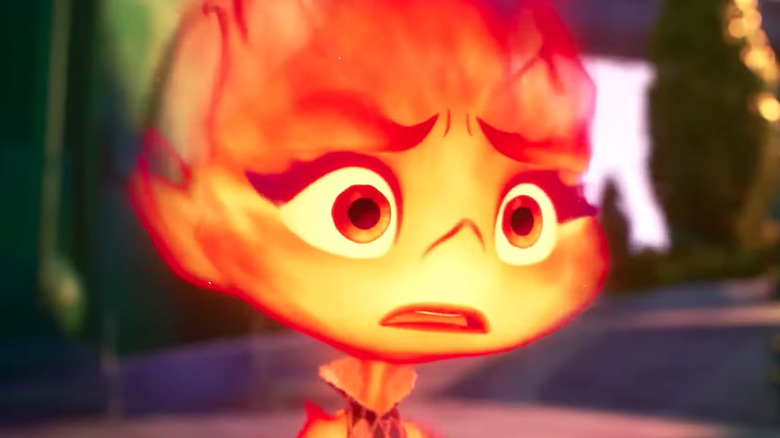Things Only Adults Notice In Elemental
The elements of Pixar's "Elemental" live in a spectacular world. Element City has everything they could possibly want, whether they're made of fire, water, earth, or air. For many, the only thing that's missing is that special someone, and for that there's a rule: Elements don't mix. So when Ember (Leah Lewis), a fire-woman, falls in love with a water-guy named Wade (Mamouduo Athie), things get a little dicey. They may live in a city where every element is accommodated, but they — and their families — aren't prepared for the pair to come together.
"Elemental" is a rom-com about two people from different worlds finding common ground. It's a familiar tale made unique by the incredible animation that brings the story to life. From the stadium where air-ball is played and the shiny, watery palace where Wade lives with his family to the squat housing where Ember's father has his shop, Element City is full of original places and fun details. But while children will enjoy this story of two people falling in love, adults will notice the richer details. Here are 10 things that only adults notice in "Elemental." Spoilers ahead.
The fire-people are renamed like immigrants at Ellis Island
People come from all over to find a home in Element City, but Ember's parents are among the first fire-people to arrive there. When their ship docks at the entrance to the city, they join all kinds of elements waiting to be accepted. Unfortunately, the agent doesn't speak their language, so he renames them. Their names were simply unpronounceable to the agent, so they became Bernie (Ronnie Del Carmen) and Cinder (Shila Ommi). Perfectly good names for fire-people, the kids in the audience are likely thinking at this point — but they have nothing to do with their own language.
As the grown-ups watching will no doubt notice, this scene is meant to resemble how people at Ellis Island and other immigration entrances around the country entered the United States. While people who spoke English were able to enter with their names intact, those who didn't were given different names based on what the agent who was assigned to them decided made sense — or, at least, that's what many people believe. However, outside of some isolated incidents, Ellis Island officials were probably not responsible for the name changes that took place.
According to research conducted by Smithsonian magazine, many of the immigration inspectors at Ellis Island were immigrants themselves and between them were capable of speaking a variety of languages. Italian, Polish, Ukrainian, Slovak, German, Yiddish, French, Greek, Hungarian, Russian, Ukrainian, Serbo-Croatian, Romanian, Swedish, Portuguese, Bulgarian, Czech, Spanish, Armenian, Arabic, Dutch, Norwegian, and Chinese are among the recorded languages spoken by agents on the island. The issue reportedly came from names being incorrectly taken down by staff at the shipping lines' various departure stations in Europe. "If anything, Ellis Island officials were known to correct mistakes in passenger lists," Philip Sutton of the New York Public Library said.
Ember's last name is a word for measuring light
When the agent at the border renames Ember's parents Bernie and Cinder, they also get a new last name: Lumen. While Bernie and Cinder are obviously fire-inspired words that even the youngsters in the audience will probably recognize — the burn in Bernie is clear and Cinder is a word for partially burned charcoal or wood — Lumen is less obvious. So, even though children are likely to accept Bernie and Cinder as the fire-people's names, they may wonder about Lumen. However, the adults watching will likely know that Lumen is actually associated with the measuring of light.
According to the Merriam-Webster Dictionary, lumen is one of two standard international units for measuring light. If you want to wow your friends, the other is the candela. The lumen measures "luminous flux" or "how much light is actually perceived by the human eye." So, lumen is very appropriate as a last name for Bernie, Cinder, and eventually Ember. In fact, Lumen may be the most appropriate name for them as a group, because, while their first names indicate individual things about fire and burning, their last name is a general word about light that all of them can appreciate. It's a beautiful name with a fitting meaning — even if it is totally made up by an immigration official.
There are no fire people outside of Firetown
In most American cities you can find a Little Italy and a Chinatown, places where a concentration of immigrants has led to their cuisine and culture taking root. In "Elemental," the fire-people are concentrated in Firetown. While water, air, and land-folk can visit, it's the fire-people that live there. The problem is that, although children might miss it, when a fire-person goes elsewhere in Element City, it always seems like they're the only fire-person there. In fact, when someone asks Ember if she's been anywhere besides Firetown, she tells them "no," following it up with a declaration that she has everything she needs there.
While that attitude may help keep Firetown going, it doesn't help the fire-people integrate into the larger Element City. That's a shame, because Element City as a whole is a vibrant community full of different elements. In fact, in the places that Wade and Ember go, water, air, and land-people seem well-integrated, whether it's on the streets in the city center or in the stadium for the air ball game. Fire, however, is underrepresented. Perhaps this is because of intolerance on the part of the other elements. After all, fire is the only element that is not allowed into the exhibit to see Ember's favorite flower. For one reason or another, the fire-people have mostly stayed in their own part of the city — and the rest of the city is a lot poorer for it.
Ember is powering the hot air balloon
Hot air balloons are a wonderful way to travel but they aren't used as a regular mode of transportation, neither in the real world nor in Element City. Nonetheless, at one point in "Elemental," Ember and Wade go to the roof of Ember's house so Ember can assemble a makeshift hot air balloon out of parts and they can take off. During their hot air balloon tour of Element City, Wade asks Ember to go here and there, as if she's in control of the balloon. But, while kids will notice that Ember appears to be piloting the hot air balloon, they may miss the fact that she's actually powering it.
Each element of Element City has its strengths and one of the lesser-known strengths of fire-folk is that they can power hot air balloons. The fire that powers their whole bodies can also serve as the flame that puts hot air balloons in the air. So, while in the real world the balloon is placed over a burner that is lit and stoked by a pilot, in Element City there is no need. Fire-people are a natural source of power and they have even more control over the fire that powers the balloon than people in the real world.
The overexposed photo is because of Ember
Ember and Wade start a nice relationship, but if Ember's father knew, it would be a big problem. So it's a good thing that the one photo she has of the two of them is overexposed. Only two pairs of eyes and a flash of light can be seen. Why is that? It's obvious to the grown-ups in the audience, but what the children may not realize is that the flash that reduces the rest of the photo to two pairs of eyes was caused by Ember.
The fact that Ember could cause the photo to be overexposed with her fiery exterior is handled in a subtle way. Wade never says the photo is overexposed because of her, and, unlike in other situations — like at the movie theater where Ember still glows when the lights go down — the photo isn't immediately obvious, because when we see Ember and Wade posing for it, they look perfectly fine. Plus, Wade and Ember never lament the fact that the photo doesn't depict the two of them in their full glory. As a result, it's easy to overlook the fact that Ember is the culprit for the photo's overexposure. Still, the fact that this is what happens when she takes photos may have some people wondering why she bothers to take photos at all.
Ember is discriminated against in a variety of ways
Discrimination is rife in the real world, and it's the same in Element City. In Firetown, Ember is just one of many fire-folk, burning bright and going about her business. But the moment she steps outside of Firetown into the wider world, she encounters bigotry, even if it's just a water, air, or land-person following her with their eyes. Ember hasn't been outside of Firetown before the events of the film, so she hasn't experienced a great deal of prejudice up until that point. But, when she meets Wade, that changes. While adults and children alike will recognize the most obvious examples of the hurtful discrimination directed at Ember, some of it is more subtle.
When Ember goes to the movies, those around her mumble under their breath. They don't say anything directly to her, but that doesn't mean she isn't aware of it. And, while Wade doesn't treat her any differently, when he goes to see his family, one of them comments that she speaks the language well. Of course, Ember doesn't have an accent because she's lived in Element City her whole life. In other words, she has just as much experience speaking the language as any one of Wade's relatives, but she's still seen as an outsider because her parents arrived in the city as immigrants. As Ember takes all of this in her stride it might go over the heads of younger viewers, but the adults in the audience will definitely feel uncomfortable seeing her being treated this way.
Ember's father is prejudiced toward the other elements
Ember is clearly the victim of discrimination in "Elemental," but that's not to say that the fire-people don't have prejudices of their own. While it isn't a widely explored part of the movie, it's hard to overlook that Ember's father is prejudiced toward the other elements, especially water. He and his wife were turned away by water, land, and air-people when they first arrived, and now that Bernie has established himself as a thriving shop owner, he takes exception to other elements coming into his place of business. In fact, when two young water-people come into his store and start poking around, he pays special attention to them so he can chase them out of the store when they mess up — something he's certain they're going to do.
This is another reason why Ember is so worried about falling in love with Wade. There's no way her father will approve of her choice, so she'd rather not take the chance on him. Of course, Wade's charms ultimately win her over and she falls for him anyway, despite all the trouble it's bound to cause. Some adults who go to see this movie will no doubt have experienced similar things with their parents, as research has shown that people tend to become more prejudiced as they get older. "They cling to the traditions and the conventions of their society in a stronger way," Steve Taylor, a senior lecturer in psychology at Leeds Beckett University, told Business Insider.
The clothes are appropriate to the kind of element
In the real world, our clothes can be made of all sorts of things, from cotton and silk to leather and denim. This isn't the case for the residents of Element City. They all have different properties so they can only wear specific kinds of clothing. Earth and air have the widest parameters on what they can wear. Air-people tend to don cotton shirts that let them move and float. Earth-people like to wear cotton, too, or nothing at all, depending on their level of comfort and confidence. Meanwhile, water and fire-people have stricter parameters.
While water-folk can technically don a variety of apparel if the need arises, if you look closely, most of their clothes are waterproof — even water-people don't want their clothes to get wet. Fire-people, on the other hand, have the least amount of wiggle room out of all the elements. Their clothes are created from tempered metal made to withstand their hot temperatures. If they put anything else on their bodies besides that, it'll burn up, so their clothes are very important, both for the safety of themselves and others. While the different elements wear different kinds of clothes depending on who they are, they all manage to share the same space inside Element City, and because of that, children may not notice these differences.
Ember makes a good point about Wade's privilege
At one point in "Elemental," Wade and Ember get into a fight. Wade wants Ember to tell her father that she doesn't want to take over the store for him, but Ember tells Wade that she can't do that. In immigrant families, she says, everyone does what's required of them, not what they want to do. Some kids watching the movie, especially those with non-immigrant parents, probably won't understand Ember's protests — and Wade doesn't either, because he is from a privileged water-family that's lived in Element City for generations. He can get away with doing whatever he wants because there are no expectations placed on him. His mother will be fine regardless because she already has money and isn't relying on him for it.
While it's true that Ember is scared to tell her family what she really wants to do with her life, she also isn't wrong about Wade. Wade is privileged, and even though he's right to encourage her to forge her own path, he doesn't understand how much harder that will be for her than it would be for him. The same thing can happen in the real world: While some people have parents that will let them follow their bliss in any direction it leads, others have a lot more expectations riding on them, be it taking over a business or having a specific career. While those expectations can sometimes work out, at other times, the child wants something different, and it can create all kinds of pressure.
Blue flames are hotter than orange and yellow flames
When Bernie and Cinder come to Element City, they bring with them the Blue Flame, a fire from Bernie's family that represents the eternal flame of their family. Why is it blue? We can only guess. But the blue flame becomes a big part of the story. The blue flame takes up a whole corner of Bernie's store and Ember has been hearing about the need to keep the flame stoked for so long that she has more reverence for this symbol than for anything else. Yet, when people are asked to envision a fire, they tend to imagine a yellow or orange flame. After all, that's the fire they see the most often.
The funny thing is, though, that yellow and orange aren't the hottest types of flame. Fires toward the purple and blue end of the spectrum are hotter, but children may not know this. According to the Firefighter Insider, blue flames reach between 2550 and 3000 degrees Fahrenheit. Meanwhile, orange flames burn at 2000 degrees Fahrenheit at the most, and yellow flames burn at up to 2220 degrees Fahrenheit. In other words, while it may all feel equally hot to humans, blue flame is actually substantially hotter than orange or yellow flame. So maybe the fact that Ember looks up to this blue flame is no coincidence.
